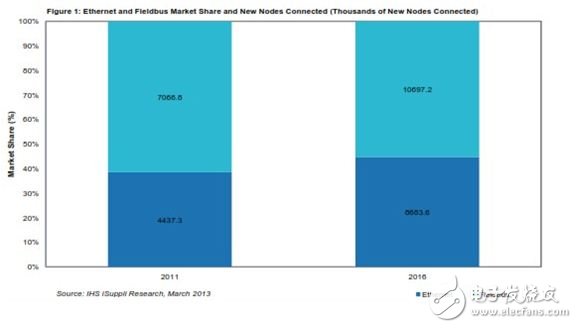According to research by IMS Research, a subsidiary of IHS, Ethernet nodes in the process industry are expected to nearly double from 2011 to 2016, and they continue to challenge the dominant position of fieldbuses in the industrial network market.
Shipments of industrial Ethernet nodes in the process industry are expected to reach 8.7 million in 2016, a 96% increase from 4.4 million in 2011, as shown in Figure 1. This means that industrial Ethernet will account for 45% of network nodes in the process industry in 2016, up from 39% in 2011. Fieldbus will pay a price for this, and the growth rate during the same period is expected to be 51%.

Figure 1: Ethernet and fieldbus market share and new nodes (thousands of new nodes)
Although the process industry has always been slow in adopting new technologies, in some key areas, the adoption rate of industrial Ethernet has begun to surpass the field bus, becoming the mainstream network technology.
The security field is a good example. Although not always promoted by mandatory regulations, process safety systems—that is, safety integrated systems—will be updated quite regularly by manufacturers to ensure operator safety and maximize line up-time (and maximize line up-TIme). The shorter lifespan means that new technologies can enter the market faster and are easier to implement, because there are more opportunities to update the network when retrofitting.
Make sure you are connected
In addition, there is also a tendency to expand networking. The network is becoming homogeneous and commoditized, which means that remote monitoring and control are more accessible. This is also the case in the field of discrete automation.
Process components and systems, such as remote terminal units and distributed control systems, are also commonly connected into networks. It is estimated that about 95% of new shipments will support the network in 2016, up from 90% in 2011. This rate of increase is expected to be relatively slow, but may reach 100%. Network support products are now almost regarded as homogenous goods, and the process industry hopes to adopt them. With the enhancement of networking capabilities, the number of ordinary nodes is also increasing. This creates the conditions for using a more sophisticated network and topology.
It is expected that the use of Industrial Ethernet in the entire industrial automation field will continue to grow. IHS predicts that by 2016, the CAGR of the new process automatic network node will be slightly higher than 14%. This growth rate is much higher than the new fieldbus node, which is expected to grow less than 9% over the same period.
As the process industry adopts more industrial Ethernet, it seems a wise choice for manufacturers looking to upgrade their network infrastructure in the near future. Although the adoption rate of fieldbus is still growing, Industrial Ethernet has the advantages of network uniformity and simplicity, which can bring lower cost and longer uptime.
However, the fieldbus still has some advantages. As an important protocol in the process industry, HART can transmit signals on 4-20 mA wires, which is a major advantage for those manufacturers who use the original infrastructure. In addition, quite a few of the fieldbus solutions are left behind, meaning that a large number of machines are still using older protocols.
But Industrial Ethernet must overcome these obstacles, and it is expected that the fieldbus will have been basically replaced in the last 10 to 15 years. Reducing general management costs, making it easier to access production data and shortening downtime, these advantages will drive industrial Ethernet to be adopted more in the longer term.
Our Battery Smart Monitoring system is direct integration of the battery restore solution into computer-based battery monitoring system which combines wireless communication with patented, field-proven battery monitor and analysis technology. It not only has the ability to restore battery, but also has the ability to monitor battery's State-Of- Health(SOH) in real time. It is much more intelligent than Smart Pulse Protector and Pulse Restore System because of it's battery remote management and maintenance function with wireless communication.
It is comprised of 3 base hardware which consists of a monitoring host, several monitoring modules, and several data box modules. Plus 1 software operation system. The monitor parts connected wirelessly with batteries pack and reliably reports battery State-Of-Health(SOH) to the software platform.
The battery monitoring system adopts a inspection module for each battery analysis and monitoring. Through the wireless communication technology, every single battery's SOH data collected by monitor is concentrated into the data box module. The data box module is used to collect the battery's voltage, temperature, internal resistance and current simultaneously. Then transmit all the data to the monitoring host which can do data displaying, analysis, storage, and alarming as soon as abnormal. 
Since the Monitoring system is integrated with Base Site Battery Protector System, The real-time improvement of the battery equalization and small pulse current desulfation, lead to the battery lifespan prolonged up to 2 times. Meanwhile, monitor battery's State-Of- Health(SOH) and State-Of-Charge (SOC) in real time to make sure keeping the back up power system always safe and uptime.
Battery Smart Monitoring System
Battery Smart Monitoring System,Battery Monitoring Intelligent System,Battery Intelligent Monitoring System,Battery Remote Monitoring System
Shenzhen Daceen Technology Co., Ltd. , https://www.daceen-sz.com
